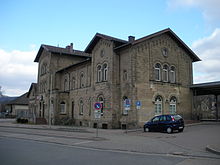Brunswick Southern Railway
| Börßum – Kreiensen | |||||||||||||||||||||||||||||||||||||||||||||||||||||||||||||||||||||||||||||||||||||||||||||||||||||||||||||||||||||||||||||||||||||||||||||||||||||
|---|---|---|---|---|---|---|---|---|---|---|---|---|---|---|---|---|---|---|---|---|---|---|---|---|---|---|---|---|---|---|---|---|---|---|---|---|---|---|---|---|---|---|---|---|---|---|---|---|---|---|---|---|---|---|---|---|---|---|---|---|---|---|---|---|---|---|---|---|---|---|---|---|---|---|---|---|---|---|---|---|---|---|---|---|---|---|---|---|---|---|---|---|---|---|---|---|---|---|---|---|---|---|---|---|---|---|---|---|---|---|---|---|---|---|---|---|---|---|---|---|---|---|---|---|---|---|---|---|---|---|---|---|---|---|---|---|---|---|---|---|---|---|---|---|---|---|---|---|---|
| Route number (DB) : | 1940 | ||||||||||||||||||||||||||||||||||||||||||||||||||||||||||||||||||||||||||||||||||||||||||||||||||||||||||||||||||||||||||||||||||||||||||||||||||||
| Course book section (DB) : | 358 | ||||||||||||||||||||||||||||||||||||||||||||||||||||||||||||||||||||||||||||||||||||||||||||||||||||||||||||||||||||||||||||||||||||||||||||||||||||
| Route length: | 105.8 km | ||||||||||||||||||||||||||||||||||||||||||||||||||||||||||||||||||||||||||||||||||||||||||||||||||||||||||||||||||||||||||||||||||||||||||||||||||||
| Gauge : | 1435 mm ( standard gauge ) | ||||||||||||||||||||||||||||||||||||||||||||||||||||||||||||||||||||||||||||||||||||||||||||||||||||||||||||||||||||||||||||||||||||||||||||||||||||
| Dual track : | Neuekrug-Hahausen-Kreiensen (formerly continuous) |
||||||||||||||||||||||||||||||||||||||||||||||||||||||||||||||||||||||||||||||||||||||||||||||||||||||||||||||||||||||||||||||||||||||||||||||||||||
|
|||||||||||||||||||||||||||||||||||||||||||||||||||||||||||||||||||||||||||||||||||||||||||||||||||||||||||||||||||||||||||||||||||||||||||||||||||||
The Braunschweigische Südbahn was built by the Herzoglich Braunschweigische Staatseisenbahn as a connection between its Braunschweig – Bad Harzburg line and the Hanover Southern Railway . It leads through the northwestern Harz foreland from Börßum via Salzgitter , Ringelheim and Seesen to Kreiensen .
In 1956, a shorter connection to Braunschweig was created with the Braunschweig – Salzgitter Bad railway line and connected to the Braunschweig – Kreiensen railway line with this line .
traffic
Today it is mainly used for regional traffic, but there is also little freight traffic . With a few exceptions, there is no longer any continuous local transport on the route. In the eastern part it is used every hour by the regional train line Braunschweig-Seesen- Herzberg am Harz . Here, a train crossing takes place at the usual minute of symmetry just before half an hour in Salzgitter-Ringelheim. The western part of the route is served by the two regional train lines Bad Harzburg – Seesen – Kreiensen and Bad Harzburg – Seesen – Kreiensen – Göttingen, each two-hourly, which together, however, do not form an hourly service; however, a direct change to the metronome from Hanover is possible for the journeys to Kreiensen, which is not possible for the journeys to Göttingen. You can only change between the two lines of the Braunschweigische Südbahn at Seesen station, although the transfer time of 15–45 minutes is rather unattractive, so that on the Bad Harzburg – Herzberg route and back, the route via Ringelheim is longer but faster. There are normally Lint - railcars used (series 648) which, if Alstom were produced in Salzgitter. In terms of tariffs, the route from Braunschweig to Seesen is part of the Braunschweig Region regional tariff and from Seesen to Kreiensen is part of the Southern Lower Saxony transport association .
history
In the Brunswick - Hanover State Treaty of 1837, which regulated the construction of the Braunschweig – Bad Harzburg railway line , a basic agreement had been reached that both states would jointly endeavor to establish a connection to the south. Another contract followed 15 years later. This allowed Braunschweig to build the Hannöversche Südbahn over the Braunschweigische Kreiensen. In return, Hanover allowed the construction of a railway line from Börßum (in Braunschweig) via Ringelheim (in Hanover) to Seesen (in Braunschweig). From there a construction via Harriehausen (again Hanoverian) to Kreiensen was agreed, where both lines were connected. The line was opened on August 5, 1856; the Hanover line to Kassel was already open three months earlier .
The line developed well, in 1865 the Kreiensen – Altenbeken railway was put into operation as a western connection towards the Ruhr area. 1868 was followed by the connection of Börßum after Jerxheim at the former rail link Braunschweig Wolfenbüttel -Jerxheim- Oschersleben - Magdeburg . This connection had become an important east-west route, with traffic in the direction of Göttingen – Frankfurt being stronger than that in the direction of the Ruhr. The Herzberg – Seesen railway line , which was connected in 1878, did not meet expectations.
After the division of Germany , the traffic flows changed. All railway lines that crossed the inner-German border between Helmstedt ( Braunschweig – Magdeburg railway ) and Walkenried ( southern Harz line ) were interrupted, including the connections from Magdeburg via Eilsleben and Oschersleben to Jerxheim. To this end, a better transport connection for the Salzgitter area was sought. In 1956, a direct connection from Salzgitter-Bad to Braunschweig was opened by closing a gap to Salzgitter-Drütte , and from Leiferde to Drütte, the new route Braunschweig – Derneburg had been in existence since the early 1940s .
The railway line is not electrified and is now a single track from Salzgitter-Drütte to Neuekrug- Hahausen . Until Neuekrug-Hahausen it still functions as a main line . It belongs to the "Harz-Weser network" and is to be remotely controlled by an ESTW in Göttingen in the future.
Planning
As part of the northern Harz concept, the regional association for the greater Braunschweig area is examining various offer concepts for the Goslar - Braunschweig connection. One variant is to relocate the RB 43 line, which today runs from Goslar via Vienenburg to Braunschweig. This is to run between Salzgitter-Ringelheim and Braunschweig every half hour to the RB 46 from Herzberg. A double-track expansion between Salzgitter-Bad and Salzgitter-Ringelheim is compared with a new Ringelheim curve to be built. At Ringelheim station, an extension of the pedestrian underpass is also being examined so that the low entry speeds caused by the passenger crossings can be eliminated.
literature
- Josef Högemann: Railways in the Harz (I), Volume 1: The State Railways . Kenning Verlag, Nordhorn 1995, ISBN 3-927587-43-5 .
Individual evidence
- ↑ DB Netze - Infrastructure Register
- ↑ Railway Atlas Germany . 9th edition. Schweers + Wall, Aachen 2014, ISBN 978-3-89494-145-1 .
- ^ Regional Association Greater Braunschweig, Committee for Regional Transport, Item 2: Local transport plan for the greater Braunschweig area - draft, April 24, 2019, pp. 143, 151.


